'Just Try It! You'll Like It!'
A food blogger copes with a fussy hubby, wonders if picky eaters are born that way
Ruth: Why don’t you like most vegetables?
Jeff (indignant): I like green peas! And corn and green beans. I love succotash! And I love carrots and celery and green peppers.
R: Why won’t you eat broccoli?
J: Ewwwwww!
R: What about fish? You once promised to try it!
J: I lied.
—Conversation with my husband Jeff
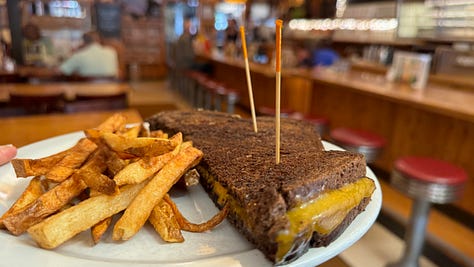

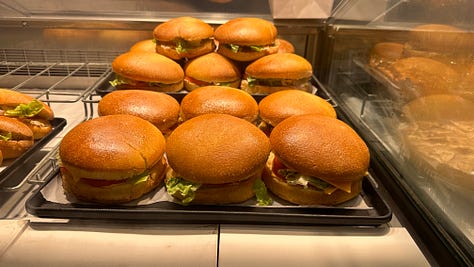
The ingredients that make a marriage work aren’t always in sync with those that lead to a successful food blog. This is the conclusion that came to mind as I pondered the subject of this week’s post—picky eaters, specifically the one I live with.
As a blogger whose main subject is food, whether whipped up in my own kitchen or consumed elsewhere, my preference would be to try unusual dishes I’ve never eaten or to cook the same, and of course I do this, at least some of the time—there’s a cauliflower salad recipe shared by a neighbor,1 a Muhammara dip prepared for a Turkish-themed potluck, a plate of typical fare sampled at a Sicilian food market, or an array of small plates at the popular conveyor-belt sushi places so common in Japan.
But my husband Jeff (aka fellow Substack blogger Jefferson Graham whose excellent website you can find here) won’t try any of these dishes. His palate is strictly limited—with foods like fish, most vegetables, many fruits (peaches, plums, red grapes, berries—except strawberries), tea, coffee, alcohol and much, much more off the table in favor of popular American fare like grilled cheese, chili, hamburgers, milkshakes, and Diet Coke. And, as much of a chocolate and ice cream lover as he is, he refuses to eat anything sweet before lunch and bristles at my questions about it.
Jeff: Who does it bother that I won’t eat a piece of chocolate before 12?
Ruth: Me!
J: It shouldn’t bother anybody.
R: You’re married to a food blogger.
J: Well, go ahead! I’m not stopping you!
Can you believe we’ve been married 43 years?
One of the sparks for this story—aside from years of stewing in a mix of frustration and resignation over Jeff’s eating habits—was a children’s book called Just Try It! by Phil and Lily Rosenthal that came out last spring. Phil created the popular CBS sitcom Everybody Loves Raymond and is also the globetrotting star and creator of the popular Netflix food and travel documentary series Somebody Feed Phil and the author of the companion cookbook, Somebody Feed Phil the Book: Untold Stories, Behind-the-Scenes Photos and Favorite Recipes. His daughter Lily, an actress and podcaster, apparently once a fussy eater who occasionally appears with Phil, along with wife Monica and son Ben in the Netflix show, is now an enthusiastic foodie.
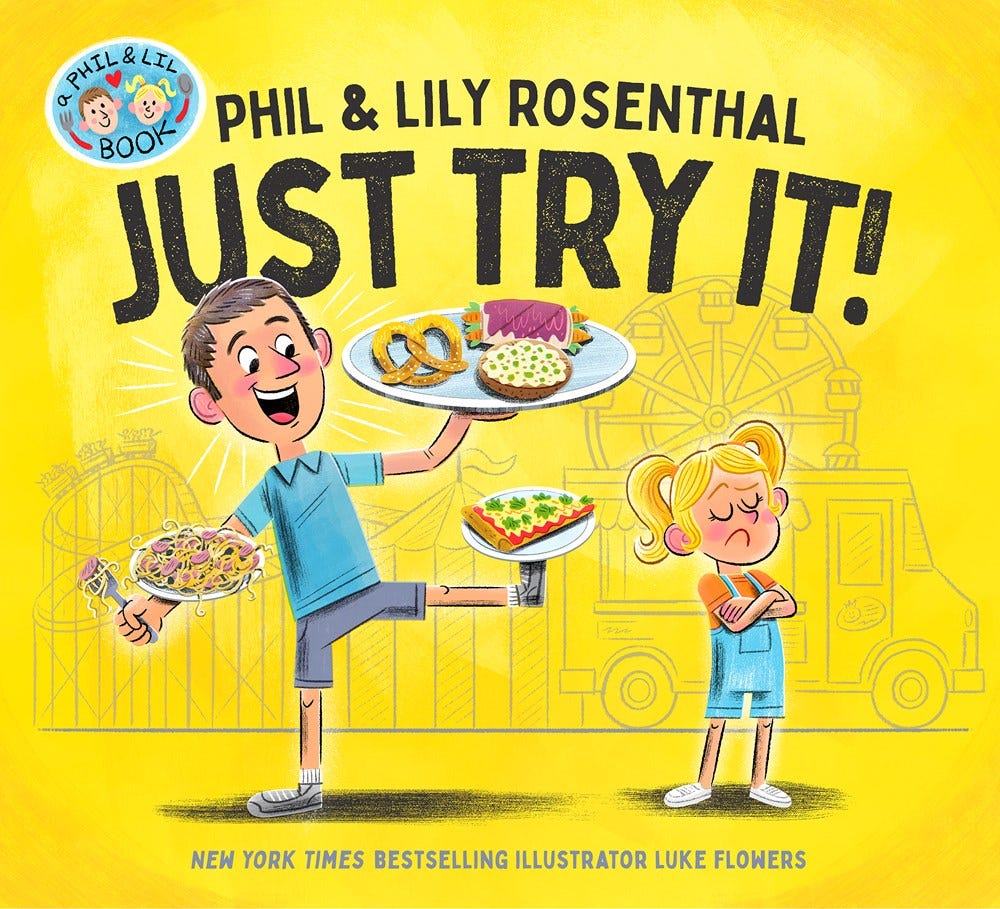
In the book, Phil takes the young Lily—whose tastes turn out to be surprisingly similar to Jeff’s—to a food truck festival and urges her to try all manner of foods: bagels and lox, linguini with clams, Peking duck in plum sauce, pizza topped with spinach and garlic. After she accidentally ingests some mustard on a pretzel and discovers she likes it, she tries everything else and decides she likes it all! Happy ending, right?
That’s the way it usually works. It’s not uncommon for children to be picky eaters and grow out of it as adults. That’s how it was for me. I remember secretly dropping Brussels sprouts under the table as a kid when my parents insisted that I clean my plate (including eating those sprouts!) if I wanted to have dessert. Many years later, after consuming sub-par fare at a college cafeteria for a semester or two, I returned home to discover my mother’s cooking had improved—or my standards had changed. It was probably a little of both, for Mom—and a lot of other American cooks—had discovered Julia Child in the meantime, so suddenly we were feasting on green beans almandine, ratatouille and coq au vin!

For Jeff, that transition to a broader food spectrum never happened, though he does claim his tastes have evolved to some degree over the years. Growing up in New York City in the ‘60s, he wouldn’t eat Indian, Thai, Chinese, Japanese or Mexican food, though there weren’t as many international eateries around as today. Now, there are at least some dishes outside his familiar western cuisine comfort zone that he’ll eat, though with restrictions—i.e., mostly made with ingredients with which he’s familiar—cheese, chicken, rice, beans and noodles. No fish. No lamb. No calamari.

What makes a picky eater?
Is picky eating inherited or learned? From a short online search, it seems it may be a little of both. According to a 2010 piece that ran in The Smithsonian Magazine, there’s a gene, TAS2R38, that determines how the tongue perceives bitter tastes. For some, those tastes are particularly strong, while for others less so. The same gene may predispose a child to prefer sugary foods and drinks, though adults with that genetic wiring are often able to overcome their sweet tooth.2
There have also been studies that show that what a mother ate during pregnancy and while nursing a baby may influence the child’s taste in foods. But there are environmental factors as well that may lead to a child’s food neophobia—the unwillingness to try something new. It makes sense that if you’re exposed to different tastes again and again, you may come not only to tolerate them but to like them—or perhaps your tastebuds just change with age.
My mother-in-law Judy had Jeff, her first child, when she was just 19 and living with Jeff’s dad Jerry in Evansville, Indiana, where he had his first job as a TV cameraman. She ate “a normal” diet for mid-’50s America, she said: meat and potatoes, not too many vegetables, cheeseburgers and fries at the local drive-in, no fish, no salad. It was only later, in her 60s, that she discovered healthier options. These days, she pretty much follows a Mediterranean diet, mostly vegetarian, except for fish. It’s a far cry from the foods Jeff recalls eating while growing up in Manhattan, NY.
With a nostalgic gleam in his eye, he rattles off the list of favorite foods he remembers, along with some of the entertainment that went with it:
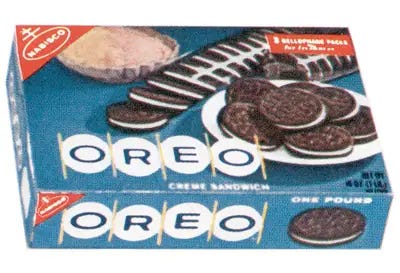


“I had Oreos. There were three rows to the cookies, and I would take one row into the bedroom and watch Felix the Cat while eating the cookies. I would eat veal chops at the Chinese restaurant because I wouldn’t eat Chinese food. I would eat pizza and hotdogs and hamburgers. I would eat Hershey bars, Sweet Tarts, spaghetti, ravioli, stuff like that. Grilled cheese, Swanky frankies (grilled split hotdogs covered with cheese), also bacon. And Dagwood sandwiches.”
Dagwood sandwiches, named after the character of Dagwood Bumstead in the long-running “Blondie” cartoon strip by Chic Young that led the Sunday comics in the local paper, were tall sandwiches made of a variety of lunch meats and cheeses modeled after the ones that Dagwood was famous for eating. In the strip, there was often a suspicious fishtail (most likely a sardine!) sticking out of the sandwich, but not the one on Jeff’s plate.
“I would make my own version with baloney, salami, and whatever other Oscar Meyer meats my mother had bought and put lots of cheese in between each slice, mustard, and then rye bread on top,” Jeff said. “I don’t think there was any lettuce.”
Along with those foods came the beloved treats that he delighted in introducing me to when we first met and which, if given his druthers, he’d still be eating—though only after lunch. Among them:
“Ding Dongs and Sunny Doodles and Ring Dings and Yodels and Snodels and Papapaloozas.”
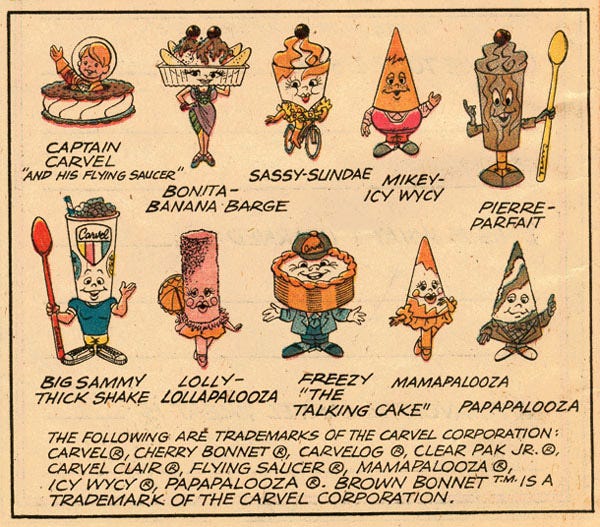
Snodels, a short-lived snack from Drake’s Cakes is a vanilla frosted, white-cake version of a Yodel—which is essentially a chocolate roll, he explained. And Papapaloozas, another long-gone favorite, were ice cream parfaits made by the beloved ice cream maker Carvel.
Jeff seems to have an encyclopedic memory for all these snack foods that were among the culinary highlights of his youth. I remember eating the occasional Hostess cupcake with the cream filling, chocolate frosting and signature white squiggle. Do you have a fond memory of a commercially made snack from childhood?
One brother is picky, one isn’t
Do picky eaters run in families? Curious about whether his younger brother Jez Graham, an accomplished Atlanta jazz musician (if you pass through the Atlanta Airport, you may catch him playing piano on Concourse A!), has the same eating habits, Jeff called him up to find out:
Jeff: My tastes have never changed. What about yours? Do you eat fish?
Jez: Yes.
Jeff: Broccoli?
Jez: Mmm hmmm.
Jeff: Asparagus?
Jez: Occasionally.
Jeff: Cauliflower?
Jez: Yes.
Jeff: Wow!
Ruth: Would you try an unusual food if you went to someone’s house and they asked you to try it?
Jez: I’d try it.
Ruth: So you’re different from your brother.
Jez: Yes, very different.
When you’re a food ‘neophobe’
In the course of looking into the causes of picky eating, I found that in its severest form, food neophobia—fear of new foods—can lead some people to have significant physical and psychological challenges: poor nutrition, body image issues, extreme weight gain or loss. There’s even a medical diagnosis called ARFID—avoidant restrictive food intake disorder.
Of course none of that applies to Jeff. He’s healthy, just cantankerous about what he will or won’t eat. “Food is just fuel—gas in the tank,” he likes to say. (Again, not encouraging for a food blogger who doesn’t share that opinion at all and would really like an opinion on a dish, but usually gets a response of “It’s fine.”)
Even though he has a limited range of foods he likes, Jeff eats a lot of soups, which, as you might for a child, I pack with vegetables he wouldn’t normally eat if he could identify them. Salads, with a limited mix of greens and veggies (no broccoli, tomatoes, cucumbers, zucchini, olives, avocado, etc.) are a constant, as are plenty of legumes, pasta and pizza. Tomato sauce is fine; raw tomatoes, no. He loves green grapes but won’t touch red ones, but he loves Welch’s Red Grape juice—but only the red, not the purple. Go figure.

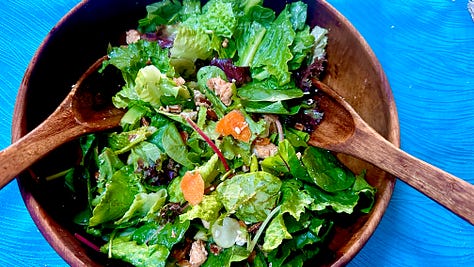
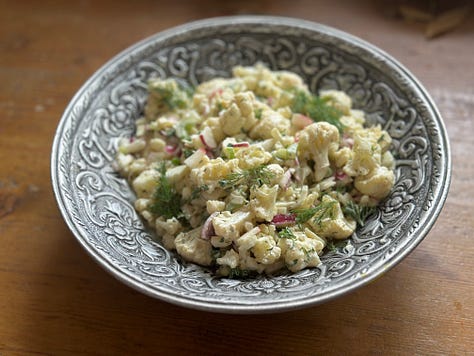
When it comes to Jeff’s favorites—grilled cheese, milkshakes, burgers—we save those for vacations—a good thing for both our waistlines. For an example, take a look at Jeff’s video from our recent return trip to Victor, Idaho.
As for my food blogging experiments? Well, I still try them, but not on Jeff. I usually trot across the street to my neighbor Susan Raycroft, whom everyone calls Susie. She is always game to taste-test my latest culinary creations. How did she develop such a broad palate?
“I think it was because we were raised in a household where you ate what you got,” Susie said. “There were five kids. We were given a variety of food. There was no room for fussiness; if you didn’t like anything, you would starve.” The very thing that Jeff actually likes—succotash—was one of the few foods she didn’t, but she ate it anyway. In her house, in contrast to mine—and Jeff’s—there were few snacks and sweets. No bribery was needed to get Susie and her sisters to finish what was on their plates.
“We were just hungry!” she said.
The bottom line
As I said, the happy ending of Phil and Lily Rosenthal’s book isn’t quite how it worked out at my house, though I do have the satisfaction of knowing that our son Sam, who I also remember being fairly picky in childhood, turned into an adventurous eater once he moved to Japan with his wife Nagisa Kamae, an artist and accomplished cook. They tell us about the new restaurants, cafes and foods they are excited to try and the wide variety of dishes Nagisa prepares and presents so skillfully (you can find them on her Instagram site here).
With the world in such a mess and our country in upheaval, does it make sense to get steamed about a fussy spouse—especially someone you love and admire (even if you can’t help poking fun at him)? I think not. I enjoy my coffee and wine; Jeff is attached to his Diet Coke and Welche’s Red Grape Juice. He orders a grilled cheese sandwich, and I a salmon steak. Sometimes we even split something. No point in arguing. Too bad our nation’s fractured politics can’t be resolved so easily.
A few questions: Do you have any picky eaters in your life and/or theories on what turns someone into one? Were you a picky eater as a child or do you have picky kids or grandkids? If you were one yourself, did you outgrow it—or are you still? I’d love to know!
That’s it for this week. Welcome to new subscribers—so excited that you’re here! Thanks to all of you for reading, liking, commenting, subscribing and just being engaged. If you enjoyed this post and this blog, won’t you please share it? Thank you!
See you next time.
Ruth
I made the recipe mostly as written, but did as my neighbor Susan Boettner suggested and added chopped parsley, radishes, and celery, and subbed Best Foods mayonnaise for the avocado mayo. After tasting, I added additional mustard (I like Dijon, but any prepared type will do), a squeeze of lemon juice and paprika. The salad benefits from resting in the fridge for a day or two to let the flavors mingle. Take care not to overcook the cauliflower. It really should be al dente. When about half of the salad was gone, I added a drained can of tuna, a bit more mayo and yogurt and piled it on a toasted slice of rye—yummy!
Brian Handwerk, “Why Are You a Picky Eater? Blame Genes, Brains and Breast Milk,” Smithsonian Magazine, November 25, 2014, https://www.smithsonianmag.com/science-nature/why-are-you-picky-eater-blame-genes-brains-and-breast-milk-180953456/



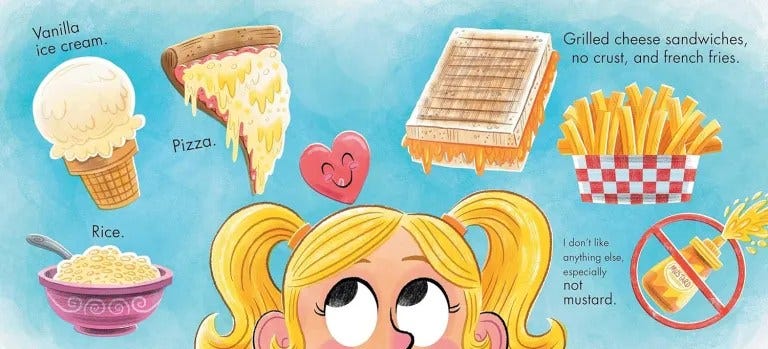




Funny article.and I don’t care what anyone thinks, I’m never eating broccoli!
There is a doughnut shop in the town where I grew up that has been there forever - and they make probably 30 or 40 varieties of doughnuts. Over the years, I have tried them all...because how would I know which is my favorite if I don't try them all?? My twin sister, on the other hand, liked the first kind she tried...and in the fifty years since then she has only ever ordered that one flavor. I DON'T GET IT.
I loved this post, Ruth, partly because I identify with it - but mostly because of the affectionate way you write about your frustrations and your husband. 💕